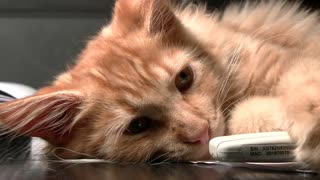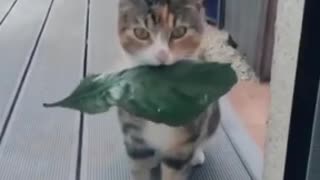Premium Only Content

cats life in Algeria
These Are The Signs That Your Cat Will Probably Live a Long Life
BEC CREW7 JULY 2016
We all want our cats to live forever (except when they’re waking us up at 6am for biscuits), and while feline immortality is still out of our grasp, it’s not that unusual for cats to live into their 20s - a solid effort for such little guys.
But how can you tell if your cat has a good shot at making it to 21 - the feline equivalent of 100 - and can you change its fate?
Two major studies have brought together knowledge from a team of veterinary experts from around the world on the common changes experienced by ageing cats, looking at everything from musculoskeletal system wear and tear to cognitive and behavioural health.
The aim was to establish the signs of healthy ageing in cats, because while it's generally accepted that there's a lot that owners and vets can do to ensure the physical and mental health of older adults, that's not much help if you don't know what signs to look out for.
This is especially pertinent now, with roughly 20 percent of cats in the US estimated to be 11 years or older.
Anyone with a cat in their life will know that they're probably going to stick around for a while, with the average lifespan of indoor house cats these days hitting an impressive 12 to 15 years.
This has increased dramatically over the past few decades, with the average cat living to just seven years in the early 1980s, and just over nine years in 1995.
If your cat ages in a healthy way, chances are they’ll even make it to their 20s. And who knows, maybe yours will rival Creme Puff, the oldest known cat, who lived to a ripe old age of 38, enjoying a rather sophisticated diet of bacon and eggs, asparagus, broccoli, and coffee with heavy cream.
High fives, Creme Puff, you were awesome.
Just to give you an idea of how incredible Creme Puff was, here’s the rundown of cat years vs human years, from the Cornell University College of Veterinary Medicine:
"[A] one-year-old cat is physiologically similar to a 16-year-old human, and a two-year-old cat is like a person of 21. For every year thereafter, each cat year is worth about four human years. Using this formula, a 10-year-old cat is similar age-wise to a 53-year-old person, a 12-year-old cat to a 61-year-old person, and a 15-year-old cat to a person of 73."
So what does healthy ageing in a cat look like? According to the two studies, published in the Journal of Feline Medicine and Surgery here and here, as your cat ages, it will likely experience several behavioural changes; changes in appearance; and functional changes, related to its physical health.
The researchers say that your cat should retain its ability to play and jump through ageing, even if it's a bit reduced, and should be able to maintain a healthy weight with no significant changes to muscle mass or body fat.
Fur might start thinning, whiskers could turn black, and the skin might go scaly with reduced cleaning.
Here's a rundown of some more normal, healthy things an ageing cat might experience:
Behavioural changes: Altered sleep cycle, altered vocalisations, reduced stress tolerance.
Appearance changes: Changes in the appearance of the eye, including lenticular sclerosis - which gives the pupil a cloudy, blue-grey-white appearance - and iris atrophy; decreased skin elasticity and brittle, thickened nails; slight changes in weight and vision. Teeth can experience a thickening of dental walls, causing them to appear yellow, off-white, or even glassy.
Daily functional changes: Change in activity patterns, decreased mobility and a decline in vision, decline in their sense of smell and hearing.
cat-ageing
(L) lenticular sclerosis and (R) glassy tooth. Credit: Journal of Feline Medicine and Surgery
The researchers also define a healthy aged cat as one that shows none of the DISHA pattern of signs that's used to identify cognitive decline in ageing dogs:
D: disorientation - getting lost in familiar areas, not recognising family members.
I: Interaction changes - social interactions might change between the pet and owner or between other pets. They might get more clingy, or more distant and irritable.
S: sleep/wake disturbances - they might sleep more during the day, or wake up at nights, or have irregular sleep-wake cycles.
H: house-soiling - going to the toilet indoors, or where they normally wouldn't.
A: activity changes and anxiety - an overall decrease in activity levels and decreased interest in play, or restlessness and repetitive behaviours such as licking.
"As in humans, many of the changes that occur with ageing in cats are not considered pathological and do not negatively affect overall wellness or quality of life," the researchers explain. "However, ruling out disease is essential when attempting to determine whether an aged cat can be considered 'healthy'."
For more info, you can read the two studies online for free here and here, and take your pal to the vet whenever you notice something amiss. Hopefully it doesn't hold a grudge for too long...
-
 0:37
0:37
Hysteria
4 years agocats life
17 -
 0:13
0:13
ninou16
4 years agoCorana from ALGERIA
65 -
 0:45
0:45
DASHATKD34
4 years ago $0.01 earnedscreaming cats
1221 -
 5:45
5:45
SportUpdate
5 years agoAFCON 2019 _ Ivory Coast vs Algeria _ Highlights
21 -
 0:14
0:14
tvchanel
4 years agoCats & Kittens
92 -
 0:38
0:38
Tori_RUSSIAN
5 years agoCats!!! Two Cats!!!
74 -
 1:08:55
1:08:55
Donald Trump Jr.
8 hours agoGlobalist Panic & Populist Prosperity, Live with Natalie Winters & Alex Epstein | Triggered Ep229
130K80 -
 LIVE
LIVE
CocktailsConsoles
1 hour agoBE PART OF THE GAME!!| Death Road to Canada | Cocktails & Consoles Livestream
72 watching -
 1:04:29
1:04:29
BonginoReport
6 hours agoFDA Vax Pusher Needs to Look in the Mirror - Nightly Scroll w/ Hayley (Ep.16) - 03/31/2025
88.5K61 -
 LIVE
LIVE
SquallRush
23 hours agoBrawlhalla Mondays!
67 watching